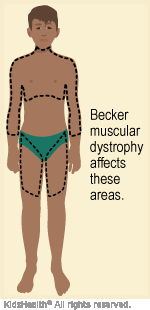Becker Muscular Dystrophy
What Is Becker Muscular Dystrophy?
Becker muscular dystrophy (often called Becker MD or BMD) is a form of muscular dystrophy, a genetic disorder that gradually makes the body’s muscles weaker and smaller. It causes less severe problems than the most common type, Duchenne muscular dystrophy.
What Are the Signs & Symptoms of Becker Muscular Dystrophy?
Becker MD symptoms can range from mild to almost as severe as the symptoms of Duchenne MD.
A child with Becker MD may start to walk later than most kids do. But the disease rarely causes health problems until a child has muscle weakness in the hips and pelvis. This usually happens when kids are 10–13 years old. Walking problems are usually noticed around age 15–16.
A child with Becker MD may:
- have more difficulty with sports
- have trouble climbing stairs
- not be able to walk quickly, run smoothly, or maintain a running pace
- have trouble lifting heavy loads
- have calf muscles that look bigger than normal, even though they’re weaker

Becker MD affects the muscles of the hips, pelvis, thighs, and shoulders, as well as the heart. Changes in the heart muscle may happen faster than in other muscles. Children who first show symptoms of Becker MD at younger ages are more likely to have heart problems than kids whose symptoms start later.
Becker MD is progressive, meaning problems get worse with age. Symptoms gets worse slowly compared with Duchenne MD. Breathing muscles tend to stay strong enough that a ventilator or other mechanical breathing help isn’t needed.
What Causes Becker Muscular Dystrophy?
In Becker MD, muscles weaken because dystrophin (dis-TRO-fin), a protein made by muscle cells, doesn’t work as it should. A change in the dystrophin gene makes the protein too short. The flawed dystrophin puts muscle cells at risk for damage with normal use.
Usually, the body will repair or replace damaged muscle cells. But in Becker MD, the cells die instead. After the muscle cells die, they are replaced by fat and scar tissue.
Who Gets Becker Muscular Dystrophy?
Among children with the Becker MD gene, boys are most affected with weakness in their arm and leg movements. That’s because the dystrophin gene is on the X chromosome. Boys have only one X chromosome, but girls have two. So girls almost always have a second copy of the gene that can make the full, working dystrophin protein. Girls can be carriers and are at risk of passing this on to their children. Girls can also have symptoms, but in general they are less severe than in boys.
Both boys and girls with a Becker MD gene can have heart problems.
Most children with a faulty dystrophin gene get it from the mother, who may carry the faulty gene without knowing it. In some children, the faulty gene is a new genetic change called a mutation or variation.
How Is Becker Muscular Dystrophy Diagnosed?
Doctors often diagnose muscular dystrophy based on the child’s family history, symptoms, and an exam.
These tests confirm the diagnosis and determine the type of muscular dystrophy:
- Creatine kinase (CK) level: This blood test checks the level of creatine kinase, a protein that normally stays inside muscle cells. When muscular dystrophy damages muscle cells, they release CK into the blood.
- Muscle biopsy: This test can show whether the muscle has any dystrophin. If there’s no dystrophin around the muscle fibers, it usually means the child has Duchenne MD. Patchy, reduced amounts of dystrophin around the muscle fibers usually mean the child has Becker MD. The doctor does the biopsy by removing a small piece of muscle, usually from the thigh.
- Genetic testing: This will show if there is a missing piece (deletion), duplication, or a point mutation in the dystrophin gene, which disrupts how the gene works. This helps the medical team decide how to treat the problem and know what to expect in the future.
How Is Becker Muscular Dystrophy Treated?
There’s no cure yet for Becker MD. Treatment is a combination of:
- slowing the disease and assisting the heart using medicines
- helping the child move around using braces and other physical aids
A child with Becker MD usually is cared for by a team of doctors and other experts from several pediatric specialties.
What Can I Expect?
Kids with Becker MD can live long, active lives, and research to improve treatment is underway.
Some people with Becker MD begin using a wheelchair in their twenties. But many over age 50 can walk without help or by using a cane, crutches, or walker.
Becker MD does not affect muscles of the bowel and bladder or sexual function.
What Else Should I Know?
- If the mother and any sisters of a child with Becker MD are found to be a carrier, they should have regular visits with a cardiologist (a doctor who specializes in heart problems).
- Children with muscular dystrophy may have a harmful response to anesthesia. If your child must have surgery, make sure the anesthesiologist is aware of the MD.
- Genetic counseling should be a consideration for any adult with a Becker MD gene before having children.
